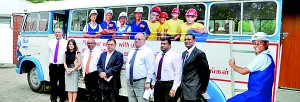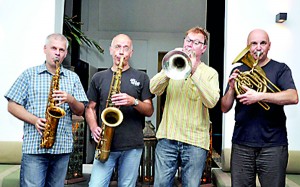Sunday Times 2
Germans’ fascination for “The Land of Legends”
This year marks the 60th year of diplomatic relations between Sri Lanka and Germany. However, stirrings of interest of Germans in Sri Lanka were in evidence long before diplomatic ties commenced. In fact, as far back as the 16th century, Germans had been visiting Sri Lanka as sailors, voyageurs, scientists and merchants and one of the earliest maps of Sri Lanka, redrawn in vivid detail in 1605 by German cartographer – Mercator, gives an indication of the extent of interest this island evoked in far away Germany.
A remarkable fact about these early Germans is that when they set foot on Sri Lanka, they had no ambitions of colonising the island. Nor plunder the wealth at a time when Sri Lanka abounded in valuable spices, precious stones and elephants which lured some of Germany’s close European neighbours in the fifteenth and the sixteenth centuries. They neither had the desire to spread their religion.
Instead, the urge of these early Germans – who were excited and curios about the “Land of Legends,” was described in the 8th century German literature – “De Universo” as “a dream of a world of plenty under the eternal sun for the people of the grey, cold North.”Sentiments of the 8th century seem to continue with German tourist arrivals of 2013, ranking third in the country.
A well-researched article written by Dr. Peter Wienand, a former Deputy Head of Mission of the German Embassy and amended later by Mr. Bernhard Mohns of the GTZ for the publication “Fifty Years of Friendship and Cooperation between Sri Lanka and Germany” reveals that from around the 16th century, the Dutch rulers, on taking over the island from the Portugese, commissioned German officers due to the failure of the Dutch to raise their own men for administration. This resulted in the arrival of high ranking officers of German descent as Governors and high judicial officers, some of whom married into Dutch families. Names such as Wolf, Spittel, Schneider, Lovenz, Weinsmann, Driberg and Dornhorst are clear evidence of German descent while German beer, German sausages, the volkwagen with the Benz car as a status symbol, whether these came then or later, have continued to be perennial favourites in Sri Lanka.
Sri Lankans stood to gain by the commissioning of German officers as the writings, accounts, chronicling, entries in diaries and commentaries were entered by such officers selected to high offices on the grounds of their qualifications. And these documentations are today invaluable to historians and scientists of many branches.
Most of the literary works of the eighteenth and the 19th centuries were efforts of Germans captivated by the island’s scenic beauty and amongst these was the well-illustrated account of the travels in the island by Prince Waldermar of Prussia.
The translation of the book of Robert Knox (held captive in Sri Lanka for eighteen years by the King of Kandy) into German in 1689, just eight years after the publication of the original English edition, gives an indication of the German interest in Sri Lanka. The book had inspired Johann Wolfgang von Goethe – considered as the greatest German poet, in the course of his studies of the orient. In 1816, he wrote that “the island of Ceylon now must be increasingly interesting to us.”
The flow of German entrepreneurs to Sri Lanka commenced in the British Period with the prosperity of the economy and its transformation to a market policy. One of the pioneers of tea plantations in Sri Lanka was a German – Maurice Wormser whose tea estate in Pussellawa – Sogama was named after him and his two planter-brothers, Solomon and Gabriel. Sogama continues as one of the best plantations to this date. The interest in ventures caught on and lasted for hundred years.
Considered as the most enterprising German national however was Philipp Freudenberg – a name still familiar in the Colombo business circles. Philipp – the earliest member of the Freudenberg family set up his own firm at a time when the German Empire (founded in 1871) was an important trading partner of Sri Lanka. By 1876, the magnitude of the interests of Germans in Sri Lanka was such that the German Empire appointed Freudenberg as the Consul, representing German interests in Colombo. “Pflenzerleben in Ceylon, 1923″ edited by two German planters – John Hagenbeck and Christian Boehringer gives an insight into the plantation industry of the time. Hagenbeck – an arrival of 1885, also wrote “Twenty five Years in Ceylon” based on his roaring shipping business in Colombo and his animal-export venture. This had been a well read book in Germany.
The two World Wars in the meantime took its toll of the bustling German enterprises in Sri Lanka with German property being confiscated by the British and German nationals interned. By 1930, all German ventures were shut down.
A spiritual awakening, in the meantime, was emerging in the war-scarred Germany at the turn of the 20th century when Germany found solace in Theravada Buddhism. One of the inspired Germans – Anton W.F. Gueth – a pillar of the Theravada Buddhism in Europe, arrived in Sri Lanka and in 1903, became the first foreigner from the West to be ordained as a Bhikkhu under the name Venerable Nayanatiloka MahaThera followed by Siegmund Feniger, who was ordained as Venerable Nayanaponika Thera. Today, several Germans, disillusioned by materialstic trappings of the West, continue to live the sparse life of Bhikkhus and Bhikkhunis, both here and in Germany.
Buddhism in Germany was thus making progress. “The Buddhist House” founded by Dr. Paul Dahlke in 1924, was drawing scholars and holding in-depth discussions on the Buddhist Doctrine. By 1952, this was converted to “Berlin Vihara” by the Sri Lankan – Asoka Weeraratne which continues as a centre for Buddhism in Europe. It is estimated that around 60,000 Europeans, mostly Germans, are turning to Buddhism yearly. Several German scholars and academicians in the meantime were attracted to Buddhism, literature and culture of Sri Lanka. The most illustrious amongst them was Wilhelm Geiger who is held in high esteem by the Sri Lankans for bringing the Mahavamsa – the backbone of the island’s history, closer home.
Geiger arrived in Sri Lanka in 1895. Deeply impressed by the ancient historical chronicles and Buddhist literature, he translated into English the Dipavamsa and the Mahavamsa which led scholars to hail his work as the true beginning of scientific work in the Buddhist literary field.
The construction of the Randenigala and Rantambe dams in the Accelerated Mahaweli Development programme are monuments to the sixty years of Sri Lanka-German diplomacy. They cemented the bonds for a lasting friendship between the two countries. This is as impressive as the indelible imprint, left by Geiger in the hearts and minds of the people with his invaluable contribution to Lankan culture, long before diplomatic relations commenced.
| Relationships extend from the heart
By Shaveen Jeewandara “The diplomatic relations between our countries go a long way, but to my understanding the most important thing is bond between the people  Pic by Ranjith Perera of our two nations,” said German Ambassador Dr. Juergen Morhard, launching the programme of events celebrating 60 years of diplomatic relations with Sri Lanka, at his residence on Tuesday together with principal partners Allianz Insurance, DIMO, IWS Holdings, Prestige Automobiles and Senok Automobiles. “There is a particular relationship between the people of Germany and Sri Lanka which extends from heart to heart, and it is the people that we must celebrate.” The main event to mark this milestone year is the Sri Lankan-German Street Festival on Sunday, October 6 from 3 – 6 p.m., at the Nelum Pokuna Road. The festival opens with a parade of vintage cars and will feature a Top German Brands Zone, performances by German brass band Talking Horns, food and beverage, football, puppet theatre, a fashion show, face painting and street theatre in addition to interactive displays by German partner organisations. “The festival will be open to all, and since we have ordered sunny weather, I am sure everybody will have a great time,” said the Ambassador as he invited the guests outside to a round of hole-in-the-wall football, where one must take rounds at kicking a football through the holes of a wall. In correspondence to the celebrations in Sri Lanka, a photographic exhibition titled ‘Landscapes of Sri Lanka’ is currently on show at the Museum of Asian Art, Dahlem, Berlin Other events celebrating the 60 years of International Relations include: a travelling exhibition illustrating the longstanding friendship between the two countries, a photography exhibition by former journalist Walter Keller, from December 6 to 9, at the Lionel Wendt, an Open Day at the Ceylon German Technical Training Institute Moratuwa on November 8, a German Food Festival at Cinnamon Lakeside, an exhibition of creative works by Sri Lankan and German Students titled ’60 on October 29 at the Goethe Institut, and a business breakfast by the Sri Lanka-Germany Business Council. German music group to perform at street festival By Smriti Daniel Nineteen years with the Talking Horns have given Achim Fink plenty of stories to tell but the very first is a simple one about how they become a group. He tells it over dinner, Andreas Gilgenberg, Nicolao Valiensi, and Bernd Winterschladen, the other three members of the group, chipping in. Other anecdotes follow – about the time they played in Rwanda improvising alongside a traditional harpist with whom the only language they had in common was music or the time in Madagascar when they stepped out of the hall and onto the street because they  The Talking Horns. Pic by Indika Handuwala wanted the people outside to be a part of their audience too. They talk about the usual audiences they’ve had, the music they’ve enjoyed making and how they’re looking forward to a string of concerts in Sri Lanka. We meet them the day after they arrive on the island just before their first gig at Qbaa. Their next is on Sunday (today) where they will perform at a street festival on Greenpath celebrating 60 years of Sri Lankan-German relations. When not performing as a quartet, they will be accompanied by four traditional folk drummers: two from the low country Raigam tradition and two Parai drummers from Mullaitivu district for their concerts in Colombo and Jaffna. Achim is anticipating these collaborations and from previous experience knows that they’re able to adapt and respond to new musical styles as a group. Says Andreas, “when it comes together it is such a wonder, it is so beautiful. As a practising Buddhist he finds improvisation an interesting experiment in staying in the present moment. Looking forward to the night’s performance and the others to come, he says “It is our goal to make a connection with our audience. We want to make this a real party or a festival. The Talking Horns will play at the Greenpath Festival today, October 6 and will also be guest performers today at Jazz Unlimited at CR& FC 5p.m. (tickets Rs.500). They then move to Jaffna College, Vaddukodai on |October 8, for a free performance for students only beginning at 10 a.m. Their main concert is at Jaffna University, Thirunelveli on October 8 at 4:30 p.m. onwards followed by a final performance at St. Patrick’s College, Jaffna which is free and for students only. |

